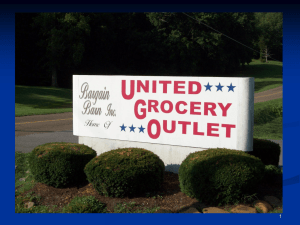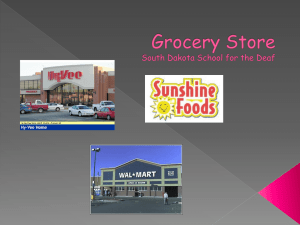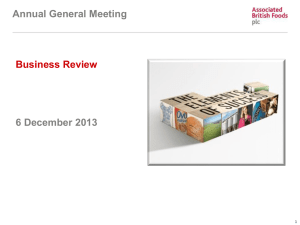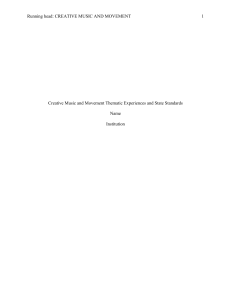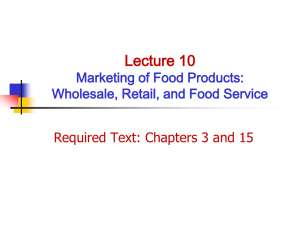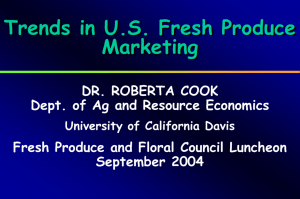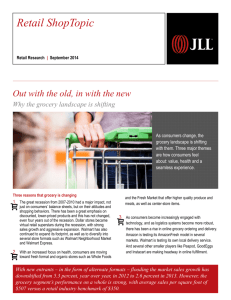FR0000 - USDA
advertisement
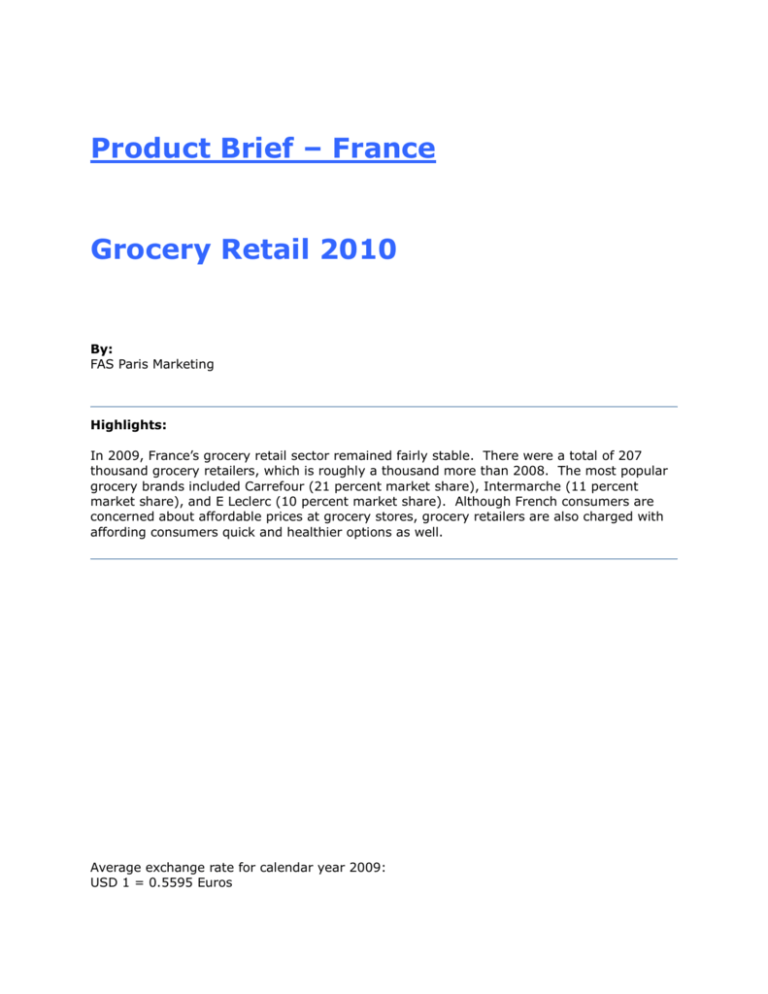
FR0000 Product Brief – France Grocery Retail 2010 By: FAS Paris Marketing Highlights: In 2009, France’s grocery retail sector remained fairly stable. There were a total of 207 thousand grocery retailers, which is roughly a thousand more than 2008. The most popular grocery brands included Carrefour (21 percent market share), Intermarche (11 percent market share), and E Leclerc (10 percent market share). Although French consumers are concerned about affordable prices at grocery stores, grocery retailers are also charged with affording consumers quick and healthier options as well. Average exchange rate for calendar year 2009: USD 1 = 0.5595 Euros Source: Central European Bank SECTION I. MARKET OVERVIEW For the world, 2008 proved to be a difficult year for consumers, namely because of the economic crisis, causing the situation in grocery retailing to worsen in 2009 as the economic disaster continued. Major drops in GDP growth led to rises in unemployment and consumer began to depend heavily on reduced purchasing power in 2009. However, France’s grocery retail sector was fairly stable, perhaps due to a series of measures the French government took in protecting it’s economy. Growth also supported sales of grocery retailers, who outperformed non-grocery retailing. Internet grocery retailing also became quite popular as French consumers are demanding quick and easy access to food. SECTION II. Market Entry More than ever, French consumers are paying more attention to obtaining good quality food products for lower prices. They are also appreciating discounts and lower prices and have been more willing to buy private label products rather than brand name products, given quality is comparable. Private label products are becoming better established in grocery retailers; this is the time for companies and retailers, who are interested in penetrating the French market, should consider doing so. Apart from price, proximity and convenience are among the major needs of French consumers, making convenience stores quite popular as well. Supermarkets performed slightly better than hypermarkets, which were perceived as more expensive and less convivial. SECTION III. Competition The year 2009 was harsh for retailers. The most important companies (with several billion dollars in sales) were better cushioned against the recession than small to mid-sized grocery retail stores, due to flexible store times such as Intermarché, Leclerc or Système U. A simple positioning like Aldi, which remained loyal to discounted products, paid off as seen by a growth in sales of 15 percent in Western Europe. Due to its focus on hypermarkets and image of relatively higher prices, Carrefour encountered a disappointing 2009 with decreases in sells of nearly five percent. Nevertheless, Carrefour continues to remain a popular brand with highest market shares (21 percent). Carrefour led the way in 2009, with a 29 percent value share, followed by SC GALEC (Leclerc) with 23 percent. SECTION IV. Best Product Prospect Hypermarkets have expanded their non-food offer and increased their services in order to differentiate from discounters and supermarkets. Non-food products, however, tended to be less of an attraction and sales decreased. Hypermarkets have suffered also from consumers’ reduced purchasing power and from internet retailing for non-food products. As a result, hypermarkets have revised their strategies in terms of pricing and offer especially during 2008 and 2009. They have tended to develop their offer in food, especially through private label and economy lines. SECTION V. Ethnic Foods in France The French have become worldlier in their eating habits, and have developed growing appetites for ethnic foods such as tacos and tortillas. The development of theme restaurants in France, which serve American, Cajun, Asian and other international cuisines, has increased the popularity of international foods, creating a demand for high-quality products. SIAL Product Brief – France Grocery Retail 2010 According to Secodip, a French research and evaluation firm, the typical French consumer who buys ethnic foods, less than 50 years old lives in cities with more than 60,000 inhabitants, is of a medium to-upper-income level, and has families with two children. He or she buys ethnic meals for their taste, not for food variety in their daily diets. Last year, French theme restaurants in Paris served about 10 million ethnic meals daily. There is an increasing interest in Asian food (Chinese, Vietnamese, Thai, and Malaysian), Cuban and Caribbean cuisines, United Kingdom and Irish dishes, as well as American, Indian, Japanese, Australian and Eastern European cuisines. Most ethnic food products in France are sold in supermarkets. The Monoprix supermarket chain pioneered the introduction of ethnic products and other chains soon followed notably Carrefour and Auchan. SECTION VI. KEY CONTACTS AND FURTHER INFORMATION International Trade Shows in France: SALON INTERNATIONAL DE L'ALIMENTATION (SIAL) International Food and Beverage Trade Show October 17-21, 2010 Parc des Expositions - Paris-Nord Villepinte Organizer: Imex Management Tel: (704) 365 0041 Fax: (704) 365 8426 Email: exposium@imexmgt.com Internet: www.sial.fr SIRHA International Hotel Catering and Food Trade Exhibition January 22-26, 2011 Eurexpo, Lyon - France Organizer: Sepelcom Tel: (33 4) 72 22 32 68 Fax: (33 4) 72 22 32 18 Email: mjk@sepelcom.com Internet: www.sirha.com SALON NATIONAL DE LA BOULANGERIE, PATISSERIE, CHOCOLATERIE - INTERSUC International Chocolate, Sugar and Bakery Trade Show Last Conference :March 8-10, 2009 Paris, Porte de Versailles Organizer: Exposium Tel: (33 1) 49 68 52 26 Fax: (33 1) 49 68 56 30 Email: jalquier@exposium.fr Internet: www.salonboulangerie.com SIAL Product Brief – France Grocery Retail 2010


